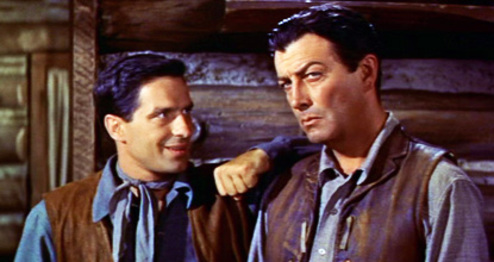
Saddle The Wind (1958) should be a classic western. Rod Serling’s script brings an existential dread to the familiar tale of a brother trying to pull his younger brother back from a path of violence. But Saddle The Wind is undone by studio mandates and reshoots that take a superior genre film and render it commonplace. If Saddle The Wind had been made ten years later or earlier it’s doubtful that MGM would have intervened the way that they did. As things are, Saddle The Wind was made just as movie westerns began their way out, replaced by television westerns.
Unlike The Law & Jake Wade (1958) Robert Taylor is miscast as the weary gunslinger Steve Sinclair. Even though Taylor’s performance is admirable he appears too old to be John Cassavetes’ sibling. Taylor’s scenes with Julie London are stiff and lack the chemistry that the narrative demands of them. Taylor’s stoic persona keeps the matinee idol from ever really connecting with the non-professional actor Julie London. London herself gets a number but her song cuts into the pacing, slowing the narrative momentum down when it should speed up.
Cassavetes is excellent in Saddle The Wind until he appears with Robert Taylor. In these, the most important scenes in the film, Cassavetes over compensates for Taylor’s seemingly emotionless performance with a hamminess unrivaled. Taylor plays it close to the vest, more internal than external, while Cassavetes throws his performance all the way to the cheap seats. Otherwise it’s clear that Cassavetes connects with and understands what Serling is doing in his script. The pacifist message buried in Saddle The Wind must have appealed to Cassavetes who couldn’t stand violence.
Songs, mismatched styles of acting, and singers in crucial dramatic roles are all common symptoms of Hollywood’s bid for relevancy at the dawn of television and rock n’ roll. It’s relatively easy to look at these aspects of Saddle The Wind and just move passed them, accepting them as part of the film’s vintage. The obvious reshoots done on a soundstage as opposed to on location are the exception. Suddenly director Robert Parrish’s carefully crafted milieu is intruded upon by a terribly awkward shot, framed with little relevance to the shots either before or after, of an actor in an obviously artificial setting.
In some vault at either MGM or Warner Bros. there may just be the original footage. As is, Saddle The Wind is fated to be an almost excellent western. Despite the popular trappings (London’s song and the choice to cast Taylor and Cassavetes as brothers) Saddle The Wind fits more comfortably with the westerns of Anthony Mann and Andre DeToth than with the saccharine films of Ford or Hawks, even if that’s what MGM ultimately wanted. It’s a testament to the film that Saddle The Wind could be read as an anti-atomic power or anti-Korean war film.
